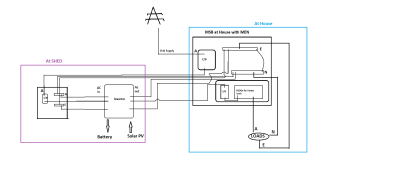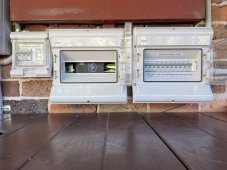Note this is in Australia, and I'm trying ascertain whether what I would like to do is reasonable/acceptable within Australian wiring rules.
I have a rural property where the existing switchboard with incoming grid power is located at the house, but I am planning on having offgrid solar setup with grid supply only as backup.
I am building a shed which will be orientated with roof orientated North for solar panel installation and will house inverter and battery, planning on using 2x Growatt SPF 5000 ES and a SEPLOS battery. My queries are about whether it is okay to run the grid power across from its current location at the house to the inverter at the shed and than back to supply the load circuits in the house which is the same switchboard location. I've tried mocking up a pretty average diagram in paint. On a side note what to other use to draw there diagrams up that are free to use?
I have a rural property where the existing switchboard with incoming grid power is located at the house, but I am planning on having offgrid solar setup with grid supply only as backup.
I am building a shed which will be orientated with roof orientated North for solar panel installation and will house inverter and battery, planning on using 2x Growatt SPF 5000 ES and a SEPLOS battery. My queries are about whether it is okay to run the grid power across from its current location at the house to the inverter at the shed and than back to supply the load circuits in the house which is the same switchboard location. I've tried mocking up a pretty average diagram in paint. On a side note what to other use to draw there diagrams up that are free to use?




